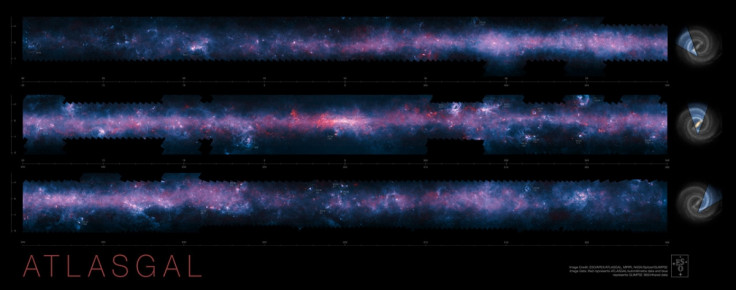Stunning image of Milky Way mapping Galactic Plane marks completion of Apex survey
A stunning image of the Milky Way that maps the full area of the Galactic Plane from the Southern Hemisphere has been released by the European Southern Observatory (ESO). The image marks the completion of the APEX Telescope Large Area Survey of the Galaxy (ATLASGAL) in Chile.
Located more than 5km above sea level, the telescope sits atop the Chajnantor Plateau in Chile's Atacama region – one of the driest places on the planet. It is 12m in diameter and allows astronomers to study the cold universe, including the gas and dust just a few tens of degrees above absolute zero (-273C).
The image is the first time this area of the Milky Way has been mapped in submillimetre wavelengths, which is between infrared light and radio waves. It shows the distribution of the cold dense gas along the plane of the Milky Way. The image also shows most of the star-forming regions in the southern Milky Way.

The Apex telescope has a host of hi-tech instruments including the Large APEX Bolometer Camera (LABOCA), which uses extremely sensitive thermometers to detect tiny temperature changes. And with almost 300 pixels, it is the largest of its kind in the world.
Submillimetre astronomy, and the study of the cold universe, allows astronomers to use light to study the chemical and physical conditions of cold clouds in interstellar space, where stars are born. "Seen in visible light, these regions of the Universe are often dark and obscured due to the dust, but they shine brightly in the millimetre and submillimetre part of the spectrum," ESO said in a statement. "This wavelength range is also ideal for studying some of the earliest and most distant galaxies in the Universe, whose light has been redshifted into these longer wavelengths."
The latest ATLASGAL survey covers an area of sky 140 degrees long and three degrees wide – four times bigger than the first from the telescope. Combined with observations from the ESA's Planck satellite, researchers should be able to detect emission spread over a larger area of sky, allowing them to work out the fraction of dense gas in the inner galaxy.

"ATLASGAL provides exciting insights into where the next generation of high-mass stars and clusters form. By combining these with observations from Planck, we can now obtain a link to the large-scale structures of giant molecular clouds," said Timea Csengeri from the Max Planck Institute for Radio Astronomy in Germany.
The ESO's Leonardo Testi added: "ATLASGAL has allowed us to have a new and transformational look at the dense interstellar medium of our own galaxy, the Milky Way. The new release of the full survey opens up the possibility to mine this marvellous dataset for new discoveries. Many teams of scientists are already using the ATLASGAL data to plan for detailed ALMA follow-up."
© Copyright IBTimes 2025. All rights reserved.






















